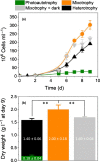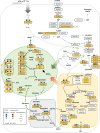Mixotrophic growth of the extremophile Galdieria sulphuraria reveals the flexibility of its carbon assimilation metabolism
- PMID: 33764540
- PMCID: PMC8252106
- DOI: 10.1111/nph.17359
Mixotrophic growth of the extremophile Galdieria sulphuraria reveals the flexibility of its carbon assimilation metabolism
Abstract
Galdieria sulphuraria is a cosmopolitan microalga found in volcanic hot springs and calderas. It grows at low pH in photoautotrophic (use of light as a source of energy) or heterotrophic (respiration as a source of energy) conditions, using an unusually broad range of organic carbon sources. Previous data suggested that G. sulphuraria cannot grow mixotrophically (simultaneously exploiting light and organic carbon as energy sources), its photosynthetic machinery being repressed by organic carbon. Here, we show that G. sulphuraria SAG21.92 thrives in photoautotrophy, heterotrophy and mixotrophy. By comparing growth, biomass production, photosynthetic and respiratory performances in these three trophic modes, we show that addition of organic carbon to cultures (mixotrophy) relieves inorganic carbon limitation of photosynthesis thanks to increased CO2 supply through respiration. This synergistic effect is lost when inorganic carbon limitation is artificially overcome by saturating photosynthesis with added external CO2 . Proteomic and metabolic profiling corroborates this conclusion suggesting that mixotrophy is an opportunistic mechanism to increase intracellular CO2 concentration under physiological conditions, boosting photosynthesis by enhancing the carboxylation activity of Ribulose-1,5-bisphosphate carboxylase-oxygenase (Rubisco) and decreasing photorespiration. We discuss possible implications of these findings for the ecological success of Galdieria in extreme environments and for biotechnological applications.
Keywords: Galdieria sulphuraria; mixotrophy; photorespiration; photosynthesis; red algae.
© 2021 The Authors New Phytologist © 2021 New Phytologist Foundation.
Figures





Similar articles
-
Regulation of photosynthesis in the unicellular acidophilic red alga Galdieria sulphuraria.Plant J. 2007 Aug;51(3):500-11. doi: 10.1111/j.1365-313X.2007.03159.x. Epub 2007 Jun 21. Plant J. 2007. PMID: 17587234
-
Untargeted Metabolomics Unveil Changes in Autotrophic and Mixotrophic Galdieria sulphuraria Exposed to High-Light Intensity.Int J Mol Sci. 2021 Jan 27;22(3):1247. doi: 10.3390/ijms22031247. Int J Mol Sci. 2021. PMID: 33513853 Free PMC article.
-
EST-analysis of the thermo-acidophilic red microalga Galdieria sulphuraria reveals potential for lipid A biosynthesis and unveils the pathway of carbon export from rhodoplasts.Plant Mol Biol. 2004 May;55(1):17-32. doi: 10.1007/s11103-004-0376-y. Plant Mol Biol. 2004. PMID: 15604662
-
Significance and Applications of the Thermo-Acidophilic Microalga Galdieria sulphuraria (Cyanidiophytina, Rhodophyta).Plants (Basel). 2024 Jun 27;13(13):1786. doi: 10.3390/plants13131786. Plants (Basel). 2024. PMID: 38999626 Free PMC article. Review.
-
Mixotrophy, a more promising culture mode: Multi-faceted elaboration of carbon and energy metabolism mechanisms to optimize microalgae culture.Bioresour Technol. 2023 Oct;386:129512. doi: 10.1016/j.biortech.2023.129512. Epub 2023 Jul 20. Bioresour Technol. 2023. PMID: 37481043 Review.
Cited by
-
Cell adaptation of the extremophilic red microalga Galdieria sulphuraria to the availability of carbon sources.Front Plant Sci. 2022 Sep 15;13:978246. doi: 10.3389/fpls.2022.978246. eCollection 2022. Front Plant Sci. 2022. PMID: 36186036 Free PMC article.
-
Metabolic modeling suggested noncanonical algal carbon concentrating mechanism in Cyanidioschyzon merolae.Plant Physiol. 2025 Feb 7;197(2):kiaf019. doi: 10.1093/plphys/kiaf019. Plant Physiol. 2025. PMID: 39820711 Free PMC article. No abstract available.
-
Costs of photosynthesis and cellular remodeling in trophic transitions of the unicellular red alga Galdieria partita.Commun Biol. 2025 Jun 7;8(1):891. doi: 10.1038/s42003-025-08284-5. Commun Biol. 2025. PMID: 40483364 Free PMC article.
-
Growth parameters and responses of green algae across a gradient of phototrophic, mixotrophic and heterotrophic conditions.PeerJ. 2022 Jul 21;10:e13776. doi: 10.7717/peerj.13776. eCollection 2022. PeerJ. 2022. PMID: 35891646 Free PMC article.
-
Mitochondrial apolipoprotein MIC26 is a metabolic rheostat regulating central cellular fuel pathways.Life Sci Alliance. 2024 Oct 11;7(12):e202403038. doi: 10.26508/lsa.202403038. Print 2024 Dec. Life Sci Alliance. 2024. PMID: 39393820 Free PMC article.
References
-
- Allen GJ. 1959. Studies with Cyanidium caldarium, an anomalously pigmented chlorophyte. Archiv für Mikrobiologie 32: 270–277. - PubMed
-
- Avelange MH, Thiéry JM, Sarrey F, Gans P, Rébeillé F. 1988. Mass‐spectrometric determination of O2 and CO2 gas exchange in illuminated higher‐plant cells. Planta 183: 150–157. - PubMed
-
- Azúa‐Bustos A, González‐Silva C, Mancilla RA, Salas L, Palma RE, Wynne JJ, McKay CP, Vicuña R. 2009. Ancient photosynthetic eukaryote biofilms in an Atacama Desert coastal cave. Microbial Ecology 58: 485–496. - PubMed
-
- Barbier G, Oesterhelt C, Larson MD, Halgren RG, Wilkerson C, Garavito RM, Benning C, Weber APM. 2005. Comparative genomics of two closely related unicellular thermo‐acidophilic red algae, Galdieria sulphuraria and Cyanidioschyzon merolae, reveals the molecular basis of the metabolic flexibility of Galdieria sulphuraria and significant differences in carbohydrate metabolism of both algae. Plant Physiology 137: 460–474. - PMC - PubMed
-
- Barcyté D, Nedbalova L, Culka A, Kosek F, Jehlicka J. 2018. Burning coal spoil heaps as a new habitat for the extremophilic red alga Galdieria sulphuraria . Fottea 18: 19–29.
Publication types
MeSH terms
Substances
LinkOut - more resources
Full Text Sources
Other Literature Sources

